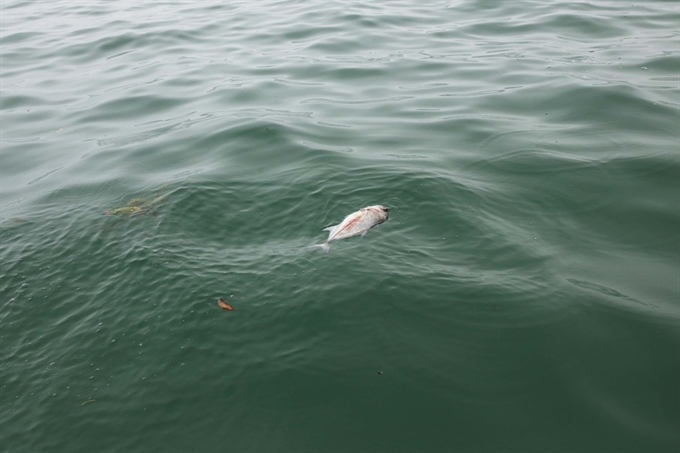 Society
Society

There has yet to be a definitive conclusion on the cause of mass fish deaths in the central region, but nonetheless, local residents whose diets rely on seafood and fishermen living along the coast from Hà Tĩnh to Thừa Thiên-Huế have been suffering.
 |
| A floating dead fish found near coast of Lăng Cô Town in Thừa Thiên - Huế. Locals are unsure about the safety of fish caught onshore used for food. — VNS Photo Phước Bửu |
by Huê Phong
THỪA THIÊN-HUẾ — There has yet to be a definitive conclusion on the cause of mass fish deaths in the central region, but nonetheless, local residents whose diets rely on seafood and fishermen living along the coast from Hà Tĩnh to Thừa Thiên-Huế have been suffering.
Nguyễn Khoa Thị Phương, of Thừa Thiên-Huế Province’s Phong Điền District, said her family had to change their diet from seafood to meat, and they are not alone.
“I have no evidence that seafood is safe for eating since the massive fish deaths. Thus, I have to get meat for meals instead of seafood,” she said, adding that meat is not favoured by her family.
Local residents have relied on seafood in light of recent reports of meat and vegetable contamination, but the fish deaths ended their last hope for safe food.
The avoidance of eating seafood has resulted in a sharp plunge in fish sales at local markets, both big and small. When news of the fish die-off broke, marine fish traders encountered many losses.
“I lost a million đồng a day during the first week (of April 20) when the fish deaths were discovered,” said Hồ Thị Liễu, a trader in the wholesale An Lỗ market in the district.
Liễu and other traders had to purchase river fish instead to maintain their businesses.
Traders in Đông Ba market, the biggest market in the province, experienced the same losses. The once busy seafood corner has received hardly any customers for nearly a month. Every market in the province is seeing the same scene.
Low sales in the market lead to fewer purchases of seafood from local fishermen, whose seafood is taken ashore after fishing trips. Ships returned to shore in the province’s Thuận An Town with batches of mackerel, small squid and other local fish species, which went unsold and were later provided as pig feed.
Hồ Văn Dạ, one of the fishermen living in the commune, said he and other fishermen stopped fishing for almost half a month because of the losses.
“Before the news spread, I saw losses and a low yield of fish after each trip - about 50 per cent lower,” he said.
“But after the news of the fish deaths, I lost two million đồng a day from fishing trips that went 1,200m out from the coast.
Fishermen in Lăng Cô Town have experienced the same situation. Nguyễn Huỳnh Kỳ, a local fisherman, said his life had become tough due to a low yield from fishing trips and the deaths of fish at his coastal farm.
Families that run restaurants on Thuận An and Lăng Cô beaches have also complained about losses, as they have received no guests for almost a month. Đào Thị Mỹ Phương, who runs Bình Phương beach restaurant in Thuận An Town, said she went nearly bankrupt over the fish deaths.
“I rented the site (for the restaurant) at a cost of 35 million đồng a month, but no guests means I lose all of that amount, plus more losses from seafood and other ingredients,” she said. “Local government should announce soon whether there are toxins in the water and how long the effects will last.”
In Quảng Bình, where many Vietnamese visitors go for good seafood, the local tourism association encouraged its members to introduce river fish and chicken as substitutes for marine fish to save falling sales in the tourism sector.
Most Vietnamese appetites rely on fish sauce, the ingredients of which are sourced close to the coastline. The fear of contaminated fish sauce has hurt sales of fish sauce and also refined salt.
For 10 days now, almost every family in Thừa Thiên-Huế has rushed to stock up on fish sauce and salt, which has caused prices to fluctuate and prompted concerns among residents.
Government efforts
The central government has delivered an urgent relief package to compensate fishermen who suffered losses in the provinces of Hà Tĩnh, Quảng Bình, Quảng Trị and Thừa Thiên-Huế.
Agribank has announced relief funding of 20 billion đồng to assist fishermen in affected areas. The bank also pledged to reduce interest rates for fish farmers that take out bank loans.
Local governments in Hà Tĩnh, Quảng Bình and Thừa Thiên-Huế have taken seawater samples for testing, which has revealed that the water is safe for swimming and seafood taken from these areas is edible. Subsidised stalls selling tuna and mackerel have been set up in the provinces to meet the local demand for marine fish.
Hoàng Ngọc Khanh, spokesman of Thừa Thiên-Huế Province’s People’s Committee, announced last Friday that coastal waters in the province were safe for aquaculture.
“Tests by the local Department of Natural Resources and Environment on samples taken from beaches and aquaculture zones around the province showed that pH levels and other chemicals and materials are within allowable levels for swimming and farming,” he said.
Local governments are also closely monitoring wastewater released by factories to the environment. Đà Nẵng, for instance, is installing a censor system to monitor contamination.
Minister of Natural Resources and Environment Trần Hồng Hà said during an inspection tour to affected provinces that the ministry would work closely with scientists and relevant parties to conduct regular monitoring of wastewater to better protect the environment. — VNS




